-
Written by: Mark ChristopherEdited by: Holly ChristopherPhotography: Holly ChristopherEditor’s note: Last summer, my husband and I accompanied our children on a musical tour of Europe. We were traveling with American Music Abroad, an organization that takes high school and college kids on European tours where they perform concerts at various locations and tour when they aren’t performing. The events in this post are one hundred percent true and have bothered my logical, science minded, rational explanation for events husband ever since it happened, hence the researching and writing. Draw your own conclusions.

Shops and apartments in Copparo, Italy We arrived in the small Italian town of Copparo and our tour buses stopped at the old town square. There was a pretty park in the center of the square with trees and a fountain. The park was surrounded on three sides by old buildings. The buildings on the left side consisted of a small bar on one corner with an old school building rounding out that side of the park.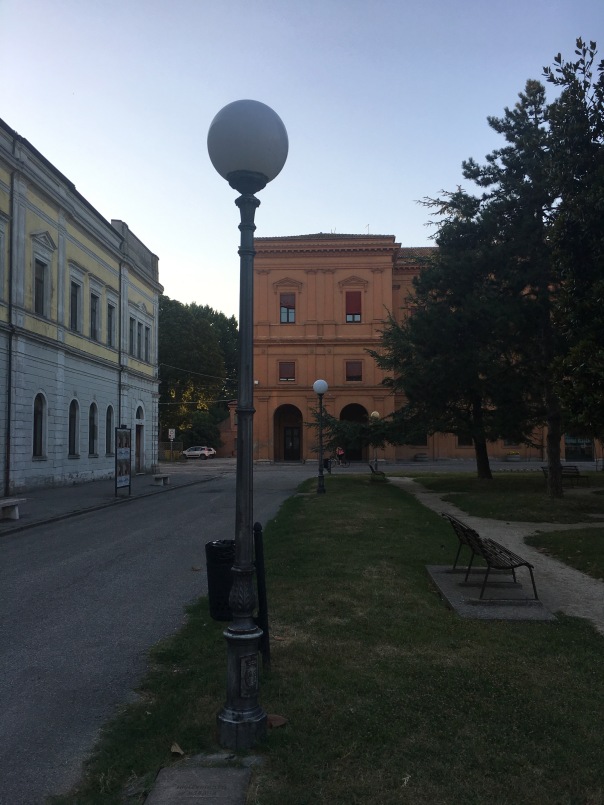
The school is the yellow and white building on the left. The municipal building can be seen at the end. On the back side of the square was the long municipal building. On the right side of the square were several tall buildings with local stores, a pharmacy and even a little gelato shop.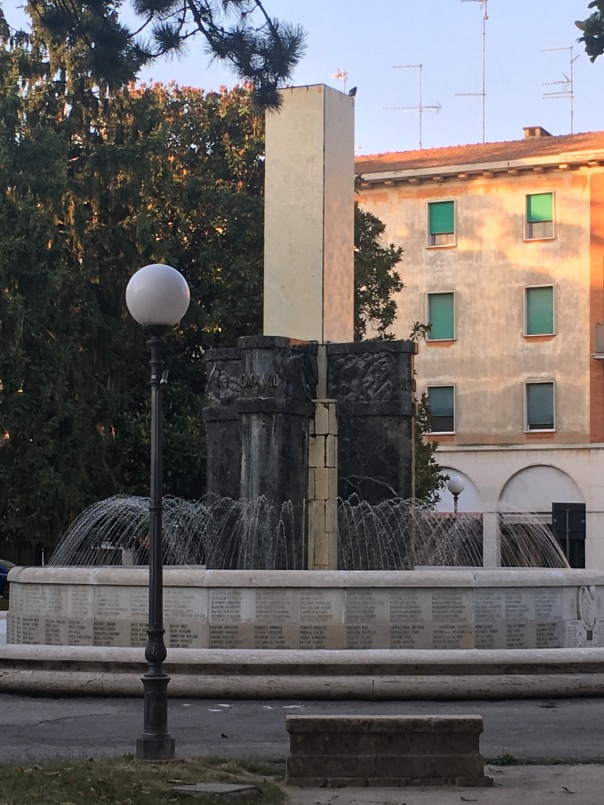
The gelato shop was behind the trees and fountain. We were traveling with a bus tour of high school and college musicians and their directors. This was their first performance on their 3-week tour of Europe. As the musicians practiced their music and got ready for the concert, my wife and I decided to take a stroll around the square. It was evening but still very light out because it was July. Somewhere between 8 or 9pm as we began our stroll. We walked to the left and passed by the small bar with its patrons talking and looking curiously at the four busloads of musicians as they scurried about preparing for the performance.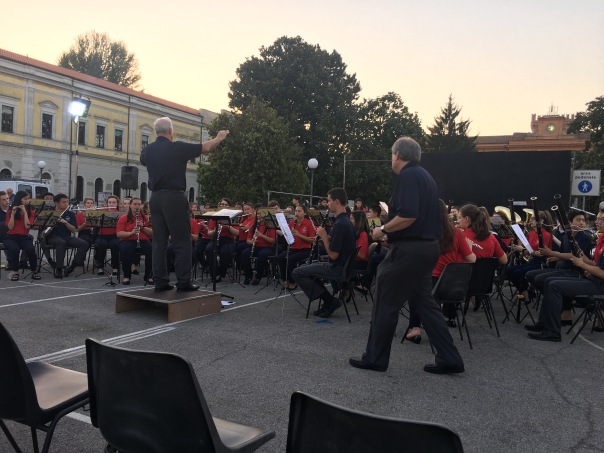
Getting warmed up for the concert. A few elderly locals were walking around the square and a few older Italian men were riding their bicycles around in circles, or finding a spot to listen to the music when it started.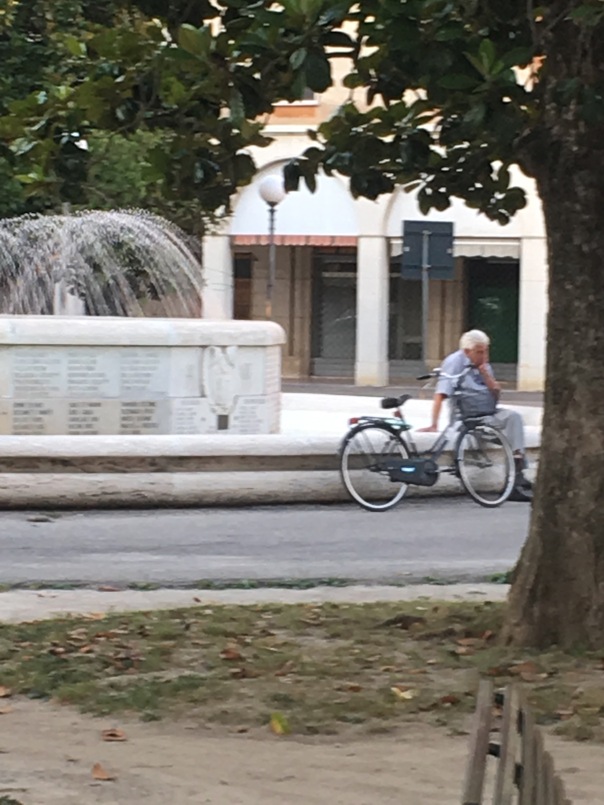
Sorry it’s blurry. Our stroll led us up in front of the tall school building on the left side of the square. My wife and I talked about how the town seemed to be frozen in time. We walked and talked taking a few pictures here and there. Soon we got to the end of the left side of the square ready to turn right along the back side of the square. That is when my wife looked at me and said “It feels like the war is still going on. Everything looks and feels as if soldiers from WWII could come walking out at anyminute.”
My wife and I talked about how the town seemed to be frozen in time. We walked and talked taking a few pictures here and there. Soon we got to the end of the left side of the square ready to turn right along the back side of the square. That is when my wife looked at me and said “It feels like the war is still going on. Everything looks and feels as if soldiers from WWII could come walking out at anyminute.”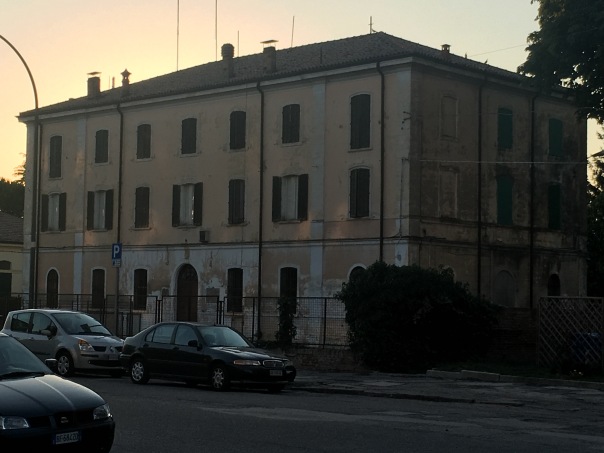
The building written about below. The municipal building is a lot or two to the right. We were both looking towards the left at an old building that reminded us of places we’d seen in war movies, when up in the sky to our right we saw a low-flying plane coming towards us. It was flying pretty low, about a hundred or so feet above the municipal building flying at an angle across the end of the square.
The municipal building complete with picturesque clock tower. The plane made its appearance to the left of the tower. It looked like a WWII plane but there was no sound. By no sound, I mean completely and totally silent. There wasn’t even the accompanying whoosh you’d hear with a glider or the snap associated with a kite. It soared directly over our heads and continued to the left of us cutting across the end of the square at an angle and disappeared out of site as it went behind the old school.We were in shock. My wife was just talking about how it felt like WWII still and a WWII plane flew right over our heads. We both said “Wow! That was amazing!” We continued our stroll and talked about the plane as we walked. We both said it looked like a smaller version of one of those large WWII bombers that Harry Connick Jr. had flown in a war movie we’d seen years ago. It was dark green, it had windows for the pilots as well as a gunner type window and all of the windows were black. We could not see any pilots inside the plane even though it was flying so low. It also had a zero on the back mid body section of the plane.
Above the awning of the gelato shop. Soon our stroll took us over to the gelato shop where we got a couple still waters and some gelato. We sat down outside the shop and talked about it some more. We discussed how strange the experience was and that it was very odd that a WWII Japanese Zero would be flying around Italy. We thought that maybe there was some type of war reenactment going on nearby. We joked about jumping through time for a moment. We finished our gelato and went back to the front ofthe square to claim a couple of seats to watch the kid’s performance.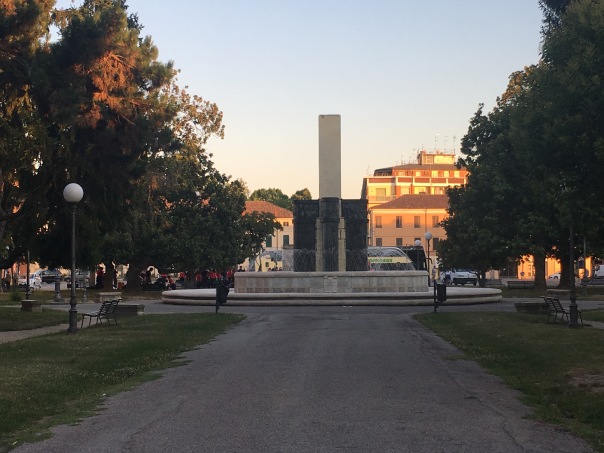
View of the square, fountain, and concert site from the back side of the square, right in front of the municipal building. You can see the kids in their red shirts to the left of the fountain. About a month later after we were back home. I couldn’t stop thinking about that night in Copparo. I decided to do some research to see if there had been a reenactment nearby on the day we were there, that could’ve explained the experience. I looked and looked, and found that no reenactments had been going on. Then I decided to see if there had been any air shows in the area. The answer was no. In fact, I found out that WWII reenactment is rarely if ever done in Europe and especially in Italy. Italy was in a bad position with regard to the war. It supported Germany for most of it and when it was clear that the Germans were losing, they flipped to the Allied side. So for most of the war they had been fighting Allied troops, and then for the last several months of the war they were being invaded from the north by the Germans and from the south by the Allies. When the war was over, Italy did not really want to remember the war, not to mention they didn’t want to do reenactments.With that avenue of research hitting a dead end. I started to research whether or not there were ever any WWII Japanese Zeros sent to fight in Italy. That was a pretty easy one, there were not. So, why did my wife and I see what appeared to be a WWII Japanese Zero flying over Copparo, Italy? There had to be some type of logical answer, didn’t there? I then started researching whether or not any type of notable event had taken place in or around Copparo during WWII. I could not find any battles or events that occurred there or were documented. Copparo was a rural town that was not critical to Italy, Germany or the Allies.I did find many stories about the “Pippo” night fighters that flew over northern Italy. A solitary plane nicknamed a “Pippo” by the locals would fly over the countryside and bomb anything that emitted light. The “Pippo” struck terror in the residents of northern Italy as they would hear the single engine plane flying over their homes and they would pray that it would not find them. Based on the accounts I read, the “Pippo” would have a loud engine sound, so it wasn’t anything to do with one of those, because the plane we saw made no sound. I kept researching and digging, which led me to an extremely startling discovery.I finally found a story about a WWII aircraft and the town of Copparo, Italy in the same article. The story stated that on April 21, 1945 a Royal Air Force Douglas A-20K Boston Mark V plane went down after being hit by a German anti-aircraft battery southwest of Copparo. Interesting I thought so, I looked for a picture of the type of aircraft that went down. Here it is… -
 I just about passed out! That was the exact plane that my wife and I saw fly right over our heads while standing in the corner of the square in Copparo in July. There was even a zero, but it turned out to be the RAF symbol. The more I read about the incident, the stranger it became. When the plane went down with four crew members aboard on April 21, 1945, it was not found. It wasn’t until 2006 that an archaeologist interviewing an eye witness to the crash in 1945, first determined the crash site using metal detectors. In July 2011 the final location of the downed plane was finally discovered during an excavation of the site. They were able to confirm the type of plane, find the bones of 4 people and small personal items such as a ring and a watch. After some intense investigation they were able to determine the exact plane and identify the four airmen. The airmen were finally laid to rest at a commonwealth war cemetery in Padua, Italy in July 2013, 68 years after their deaths.What did we see that evening in Copparo, Italy. A ghost plane? A crack in time? An event that replays itself over and over again? Four airmen trying to no longer be lost and forgotten, wanting to go home? I have no idea. My logical mind can’t explain this one. So, I leave it up to you to decide. To read more about “The finding of the Douglas A-20K Boston Mark V sn BZ590” please follow this link…
I just about passed out! That was the exact plane that my wife and I saw fly right over our heads while standing in the corner of the square in Copparo in July. There was even a zero, but it turned out to be the RAF symbol. The more I read about the incident, the stranger it became. When the plane went down with four crew members aboard on April 21, 1945, it was not found. It wasn’t until 2006 that an archaeologist interviewing an eye witness to the crash in 1945, first determined the crash site using metal detectors. In July 2011 the final location of the downed plane was finally discovered during an excavation of the site. They were able to confirm the type of plane, find the bones of 4 people and small personal items such as a ring and a watch. After some intense investigation they were able to determine the exact plane and identify the four airmen. The airmen were finally laid to rest at a commonwealth war cemetery in Padua, Italy in July 2013, 68 years after their deaths.What did we see that evening in Copparo, Italy. A ghost plane? A crack in time? An event that replays itself over and over again? Four airmen trying to no longer be lost and forgotten, wanting to go home? I have no idea. My logical mind can’t explain this one. So, I leave it up to you to decide. To read more about “The finding of the Douglas A-20K Boston Mark V sn BZ590” please follow this link… - P.S. Please excuse the poor paragraph formatting. WordPress seems to be having some issues today. First, the entire post disappeared, now, it’s formatted correctly on the page I’ve written it on, but it doesn’t show up right on the site. It happens. Have a great day and be nice to somebody. 🙂
Tag Archives: WWII
Book Opinion: All The Light We Cannot See by Anthony Doerr
I have an English degree and I have been reading intensely since I was a small child. I used to just read whatever was put in front of me without regard for the actual writing. As I’ve gotten older however, unless a book just hooks me with an entertaining story, I tend to put poorly written books in the donate box. All The Light We Cannot See by Anthony Doerr, will NOT end up at Goodwill, but will stay front and center on my bookshelf.
I am fascinated by WWII. My parents were children during it, my grandfather was an air raid warden, and growing up in the 1970’s I was bombarded by stories from that time. It has only been recently that I’ve realized what a post-war world I actually grew up in. All The Light We Cannot See offers a unique perspective on the war and a unique way of representing the thin red thread that connects us all.
The heroine of the story is Marie-Laure, a young girl living with her father in Paris. At the age of six, she loses her sight and her father creates a three dimensional model of their neighborhood so that Marie-Laure can memorize where everything is so she can get around. He takes her out with her cane and has her lead them home. He also takes her with him to the Museum of Natural History where he is the key master. She spends her time exploring the space and all of it’s treasures which end up informing her future.
At the same time, young Werner is growing up with his sister Jutta in an orphanage in a mining town in Germany. Werner is brilliant, and his quick mind causes him to live in dread of the day he will be forced into the mines. They find an old radio, which Werner works on and makes funtional. The children listen to it at night and hear broadcasts from France (they can all speak and understand French because the house mother is from France) about science. His mind continues to expand and he becomes an expert in radios.
When the Nazis approach Paris, Marie-Laure and her father leave the city, possibly carrying a priceless treasure from the museum and go to Saint-Malo to stay with her great-uncle Etienne. Simultaneously, Werner’s brilliance with radios is noticed and he is chosen to attend a school run by the Nazis. We are taken on a back and forth journey between Marie-Laure’s life in France, with glimpses of the French Resistance, the constant threat of sudden arrest, and the general quest to just survive the Nazi assaults; and Werner’s life in Germany as he struggles with things that happen at school, the pressure he feels from his beloved sister to resist what she is afraid the Nazis will turn him into, and HIS general quest to just survive the maze of treachery and horror that follows Nazi bureaucracy wherever it goes.
Eventually, the teenage Werner is thrust into the fighting by way of his magical radio skills and his life intersects with Marie-Laure’s life during the siege of Saint-Malo. Although they part, the story of their intersection continues into the next generation and for the next many years.
This story makes you ponder so many things with regard to war, and people being forced to fight for things they don’t necessarily believe in or agree with. It causes you to marvel at the strength of human beings and their spirit. It really reinforces the notion that we are all connected in ways we cannot imagine, and the things we do have impacts far beyond our immediate sphere of influence.
If you are in search of a beautifully written, multi-level story, give All The Light We Cannot See a try. I think you’ll like it.
Have a beautiful day 🙂
Book Opinion: The Wives of Los Alamos by Tarashea Nesbitt
I was attracted to this book because when I first got married, my husband was in the Air Force and stationed at Holloman AFB in Alamogordo, New Mexico. I gave up my home, my friends and my car and moved to the middle of nowhere with him. I’m from Ohio, so I’m used to green, and water, and soft spring air. I’m used to mist and rain and vegetation so lush at certain times of year that it feels like a rain forest. I’m used to sweet smells like honeysuckle and rich dark earth. Then, I moved to the desert.
The wooden seat of my grandmother’s rocking chair cracked from the dryness. I couldn’t ride my bike because of the altitude. It made my head whirl and my stomach sick to exercise, so I gained about twenty pounds. My skin dried out, my lips cracked and the inside of my nose would peel off and bleed every time I blew it. The anchor stores in the mall were K-Mart and some janky little place called Beall’s that I’d never heard of and did not like. We had one car and I was without it most of the time when my husband went to “work” on the base, and I put “work” in quotes, because most of what they did was play cards and stupid tricks on each other. Nine out of ten work days resulted in my husband coming straight home, or being home in about two or three hours because there was nothing to do and they sent everyone home. That was a good thing because my loneliness knew no bounds. Friends of ours got an illicit kitten, illicit, because our complex did not allow pets. I wanted one because I was lonesome, so we got a tiny black kitten I named Sara. She slept on my chest and chased away nightmares.
On the plus side, we had a lot of fun. It was like being in college. There were parties every weekend, and we went to most of them. Our friend Dan had us over for dinner one night and cooked steaks on the grill. I like mine well done, but these were charcoal. I yummed, and put ketchup on it and ate the parts with actual meat left in them. I drank some Seagram’s Seven in coke and like to died. To this day, I cannot stand to see even the label on a bottle in the store. Finally the day came when most all of our friends left and my husband got out of the service and we stayed. He went to work for a civilian contractor on the base, doing the same job and making three times as much money. When our friends left, it no longer felt like college, he actually had to work, and I got lonelier. Eventually, we too left and moved on to bigger and better things, but that part of my life, while miserable in so many respects was also a happy time for us. Nobody built a bomb, or did much that was top secret, but the parallels between that experience and the experiences described in /The Wives of Los Alamos/ were definitely there.
The book is written in first person, but uses “we” and “our” for example instead of “I” and “me.” For the first couple of pages, it was a little confusing, but it soon became comfortable. It was used to great effect to illustrate the communal, “we’re all in the same boat, and one is much like the other” circumstances these women found themselves in. The husbands were all physicists, recruited to work on the atomic bomb and as part of agreeing to do so, they demanded that they be allowed to bring their families. The families had no idea where they were going until they got there, and once they knew, they were not allowed to tell anyone at home. Their letters were read by censors, care package treats were stolen by censors, cars were searched, requests to leave denied and husbands were largely absent and stressed when they WERE around.
We learn about the difficulties of being without the familiar, with drying out like the desert sand, having very little water, relationships, kids, pregnancies, loss, fear, worries about the war and the brothers and friends who were fighting it, getting comfortable and then leaving. We also learn about the joys of friendship, parties, finding ways to pass the time. There are brief mentions of Oppenheimer and some of the other famous names associated with the project, but nothing too specific. This is definitely the women’s story, and really, you could call it the woman’s story, because as unique as each individual was, once they arrived at Los Alamos, they were all more or less the same.
I highly recommend this book, and not just because it reminds me of my own life. It is historical fiction from the point of view of the overlooked. It didn’t matter what these women did before they ended up in Los Alamos, or what they did after they left; while they were there, they were the wives of the men who ended a war and changed the world, for better or worse is a matter of opinion.
Have a great day and spend part of it with a great book 🙂

